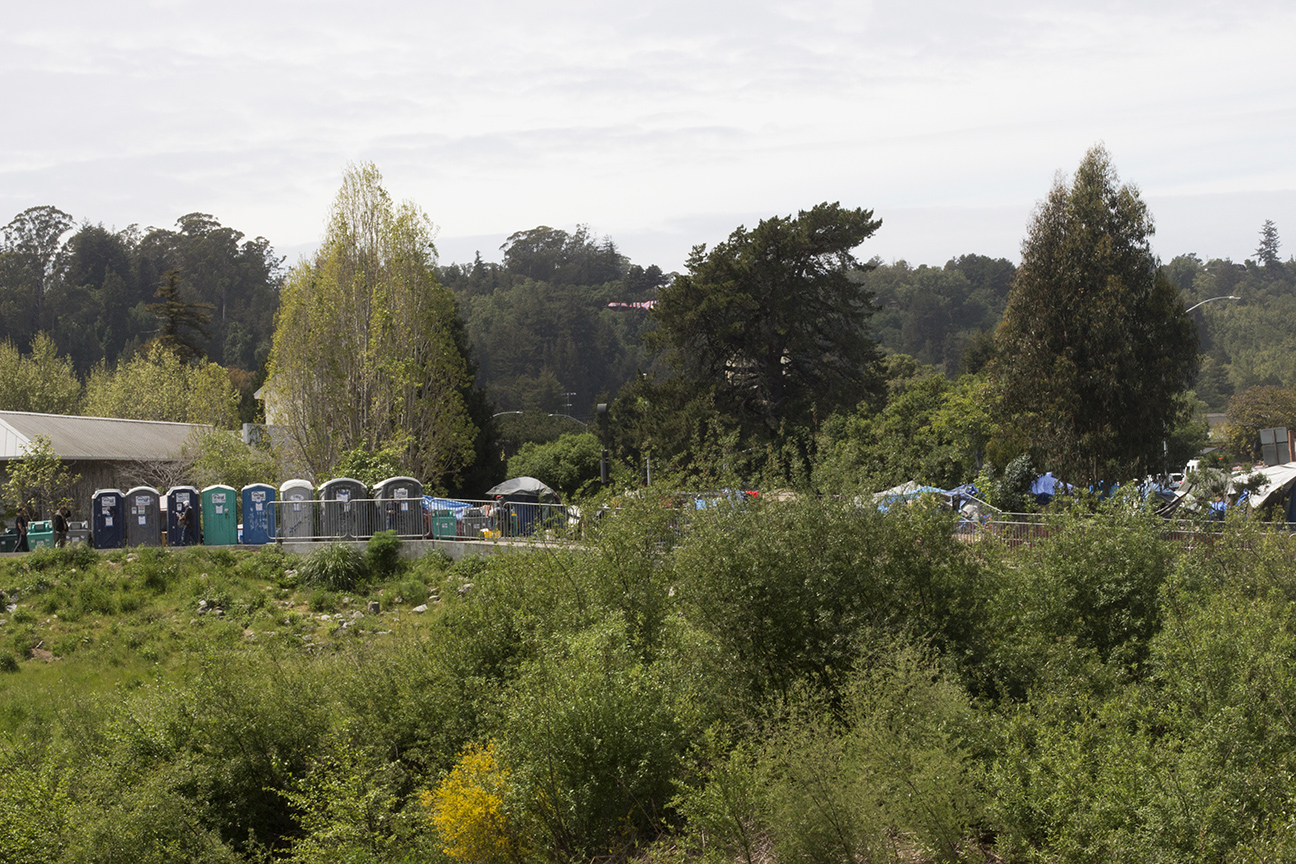TALES FROM THE HOUSING FRONT: See all the stories, or tell your own
Story and photos by Kyle Martin
In the few months it was open, Santa Cruz’s Gateway Camp was a colony of sorts. Its residents moved through rows of tents like a neighborhood, beating the dirt and wood chips beneath them into walkways. Between the tents and campers were luggage, carts and dollies, bike parts and other random belongings packed tightly into the muddy enclave.
After being disbanded this summer, the former homeless encampment is now fenced off and home to a few piles of wood chips and some overgrown foliage — instead of to more than 175 people on any given day last spring.
In April, the homeless campers behind the Ross Dress For Less department store in the Gateway Plaza at Highway 1 and River Street were ordered by the city to vacate the area, causing a massive exodus of the encampment. Susie O’Hara, assistant to the city manager, said the city tried relocating homeless campers following the camp’s closure, offering 116 vouchers for temporary stays at motels, hotels and shelters.
“A voucher was given to each resident that requested one,” O’Hara said via email, adding that the city spent $25,000 on hotel vouchers, and covered shelter stays with existing contracts with the county’s homeless service providers. “Many refused assistance.”

Even with the city’s efforts to relocate the homeless residents, the majority of those from the camp likely haven’t found their way back into a home yet. Alicia Kuhl, the former camp’s acting liaison with the city, said she feels the city displaced the camp’s residents without doing enough to find them a new place to go.
“They’ve displaced hundreds of people without adequate shelter, and they’ve criminalized them,” Kuhl, 40, said. “Meanwhile the city is not doing anything really to address the homelessness problem.”

Kuhl was one of more than a dozen plaintiffs who sued the city to keep the camp open in April. A federal court judge in San Jose ruled to halt the camp’s closure temporarily, but the camp was later closed. She said that closing the camp caused massive displacement of homeless residents and put them in harm’s way due to a lack of adequate shelter space throughout the region.
U.S. District Court Judge Edward Davila ruled against the Kuhl and the Ross Camp residents, and ordered them to vacate by May 3 at the earliest. Kuhl said her party missed a deadline to file an appeal, but said she plans to draft a new lawsuit.
While critics of the camp would point out concerns within the camp — such as rampant drug use and rodent problems — advocates and residents say it offered a place of support and safety for those traversing the streets.
Some describe the camp as a place first settled at the end of last year by a few people, which then became an exponentially greater amount by its closure in March this year. While not created as a sanctioned encampment, it was outfitted by the city with portable bathrooms and handwashing stations, security and fencing.
‘Those people haven’t gone away. They’re still here; they’re just a little harder to see.’
Evan Morrison, Santa Cruz Homeless Services Center
One thing noteworthy about the Ross Camp’s function was it helped people get services because they had somewhere to be instead of wandering the streets hoping something would change, said Evan Morrison, a veterans outreach specialist at the Santa Cruz Homeless Services Center. And it helped homeless service providers find people who needed help because they knew where to find them.
“It’s much easier to help someone get housed if they have a place to be,” he said. But to Morrison and other advocates, the camp should have been more successful — and maybe could have been, if not for its short lifespan. In the meantime, he said, many of the former residents are facing displacement and have found themselves needing a place to stay elsewhere in the city, like Santa Cruz’s other tent camp at 1220 River Street.
“Those people haven’t gone away,” he said. “They’re still here, they’re just a little harder to see.”
For many of those hoping to end their homelessness, Morrison says it likely takes about a year or more to find stable and permanent housing.
“It takes longer to get people into services than that camp was alive,” Morrison said.
He added that it’s no surprise the camp was disbanded before it made any major dent in the city’s couple-thousand homeless residents. It’s almost normal to see services like a sanctioned encampment come and go, he said.
“At this point, I expect things to be dysfunctional. And that’s the expectation I think everyone has,” Morrison said. “It seems like in this county, everybody is waiting for someone else to do it.”

Steve Pleich, a longtime advocate and another plaintiff in the lawsuit against the city, called the camp a success, but said it could have been better.
“The Ross Camp is one of those things that could have been a dream and could have been really successful,” said Pleich, a former homeless person who helped volunteers exchange needles with the camp’s residents as part of a drug abuse harm reduction program. “People want to help. You just have to give them an opportunity to do it. And I think that’s some of the most effective homeless advocacy there is.”
Santa Cruz City Councilman Drew Glover, who has drawn the ire of many around Santa Cruz for his advocacy on behalf of the residents of the Ross Camp, said part of the camp’s downfall was that it wasn’t envisioned properly from the jump to be a transitional encampment.
“Did it transition people out of homelessness? No,” Glover said. “Did it provide a sense of safety and community for people? Yes.”
While it offered a place for people to stay, it failed as a means to end someone’s homelessness, Glover said. But Santa Cruz can learn from the camp’s failure, he added.
“I don’t know if the Ross Camp was ever designed to be a success,” he said. “The real question is, why was the camp designed to fail?”

Have something to say about this story? Send us a letter.